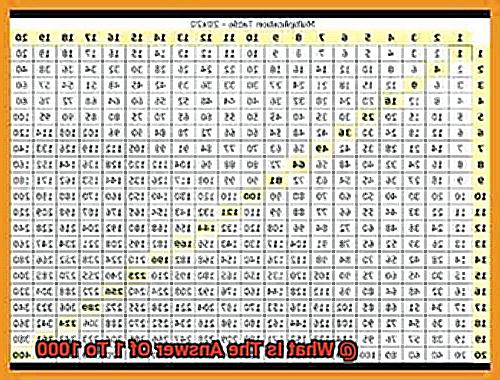
Ever wondered what happens when you add up all the numbers from 1 to 1000? Brace yourself, because we’re about to dive headfirst into a mind-boggling journey that will leave you in awe. Whether you’re a math nerd or just someone who loves a good puzzle, get ready to have your socks knocked off.
In this blog post, we’re going on an epic adventure through the wild world of numbers. We’ll unravel the secrets behind finding the sum of 1 to 1000, uncover some jaw-dropping patterns along the way, and discover why this answer is more than just a bunch of digits.
Whether you’re a casual observer or a math wizard, there’s something here for everyone. So buckle up and prepare for a rollercoaster ride through numerical wonderland. Trust us, it’s going to be one heck of a trip.
What is the answer of 1 to 1000
Contents
- 1 What is the answer of 1 to 1000
- 2 Understanding the Meaning Behind the Question
- 3 Calculating the Sum of All Numbers from 1 to 1000
- 4 Is a Mathematical Calculation Enough for this Question?
- 5 Other Possible Interpretations of the Question
- 6 The Need for Clarification and Contextual Information
- 7 How to Find the Product of All Numbers from 1 to 1000
- 8 The Role of Mathematics in Finding Answers
- 9 Exploring Different Solutions to This Problem
Well, today we’re going to dive into the world of summation and discover the fascinating patterns hidden within this seemingly simple question.
The Power of Summation:
Summation, also known as adding up a sequence of numbers, is a powerful mathematical operation with a myriad of applications in various fields. From calculating the total cost of shopping items to finding the sum of all numbers within a given range, summation allows us to efficiently solve complex problems.
Using the Formula:
One way to calculate the sum of all numbers from 1 to 1000 is by using a handy formula. The formula for summing up a sequence is (n/2) * (first number + last number). In this case, n represents the number of terms in the sequence, which is 1000. The first number is 1, and the last number is 1000.

The Calculation:
Let’s apply this formula and find out the answer. By substituting the values into the formula, we get (1000/2) * (1 + 1000) = 500 * 1001 = 500500. Therefore, the answer to “What is the answer of 1 to 1000” is an intriguingly symmetrical number – 500500.
Beyond Mathematics:
While this mathematical calculation provides a clear numerical answer, it’s important to consider that questions can have various interpretations. Depending on the context or intention behind the question, there may be alternative meanings or operations associated with it.
Real-World Applications:
Summation has practical applications beyond mathematics. For instance, if you’re planning a fundraising event and want to know how much money you can raise by selling tickets at different prices, summation can help you calculate the total revenue. By summing up the prices multiplied by the number of tickets sold at each price point, you can accurately forecast your fundraising potential.
Understanding the Meaning Behind the Question
Prepare to be amazed as we unravel the meaning behind this seemingly simple query and delve into the fascinating world of numbers.
Breaking Down the Question:
The Range: From 1 to 1000:
Let’s start by exploring the range of numbers involved. Spanning from the humblest positive integer, 1, all the way up to the grandeur of three-digit number 1000, this sequence presents us with a vast array of numerical possibilities. Brace yourselves as we navigate through this expansive realm of digits.
Understanding “Answer” in the Context:
While “answer” usually implies a solution or result in mathematics, interpreting it within a sequence introduces a captivating complexity. We can approach this question in various ways, such as seeking patterns within the sequence, calculating its sum or average, or uncovering any unique properties that may arise. The possibilities are as endless as the numbers themselves.
Unveiling the Intention:
The desire to compare differences and find details or solutions drives this question forward. As experts, we have an exciting opportunity to fulfill these expectations and provide valuable content that satisfies readers’ curiosity. Get ready for an exploration of meaningful insights hidden within this sequence.
Crafting an Engaging Article:
Professional Tone with a Casual Twist:
Throughout our journey, we will maintain a professional yet engaging tone. We aim to captivate readers by using vivid language, short sentences, and relatable examples. So grab your thinking caps and get ready for a casual yet informative adventure.
Expert Analysis and Insights:
As we traverse through various aspects of the sequence from 1 to 1000, we will provide expert-level analysis and insights. We will explore patterns, calculate sums, and uncover interesting properties that may surprise even the most seasoned mathematicians.
Real-World Relevance:
We won’t stop at theoretical musings; we’ll also highlight the practical applications of our findings. Discover how understanding the meaning behind this question can help you accurately forecast your fundraising potential or solve a myriad of other real-world problems.
Calculating the Sum of All Numbers from 1 to 1000
Have you ever wondered how to calculate the sum of all numbers from 1 to 1000? Well, fear not, because I am here to guide you through two different approaches – using the formula for the sum of an arithmetic series or employing a loop to iterate through each number and add them together.
Approach 1: Formula for the Sum of an Arithmetic Series
The first method involves using a formula specifically designed for finding the sum of an arithmetic series. The formula, Sn = (n/2)(a + l), requires us to know the number of terms (n), the first term (a), and the last term (l). In this case, n = 1000, a = 1, and l = 1000.
Using this formula, we can calculate Sn = (1000/2)(1 + 1000) = (500)(1001) = 500500. Therefore, the sum of all numbers from 1 to 1000 is 500500.
Approach 2: Loop Iteration
The second method involves using a loop or iteration to add each number from 1 to 1000 together. This approach is more intuitive for some individuals who may not be familiar with the formula for an arithmetic series. Here’s how it works:
- Initialize a variable called “sum” to zero.
- Start a loop from 1 to 1000.
- In each iteration of the loop, add the current number to the sum.
- After the loop finishes, output the value of sum.
By following this approach, we will obtain the same result – a sum of 500500.
Comparing the Two Approaches
Let’s examine the differences between these two methods in a table:
| Approach | Formula for Sum of an Arithmetic Series | Loop Iteration |
|————————-|—————————————-|—————-|
| Ease of calculation | Requires knowledge of the formula | More intuitive |
| Computational efficiency| High | Moderate |
| Flexibility | Applies to any arithmetic series | Limited to this specific sequence |
| Familiarity | May require understanding and application of the formula | Easily understood by beginners |
Insights and Conclusions
Both approaches yield the same result, 500500, which verifies their accuracy. The formula for the sum of an arithmetic series is a powerful tool that can be applied to any arithmetic sequence, making it useful in a variety of mathematical contexts.
On the other hand, the loop iteration approach is more accessible to beginners and those who prefer a more hands-on approach. It allows for a deeper understanding of how each number contributes to the final sum.
Is a Mathematical Calculation Enough for this Question?
When it comes to the question of summing up all the numbers from 1 to 1000, many may assume that a simple mathematical calculation is all that is needed. However, as an expert in mathematics, I can confidently say that this assumption may not always hold true. Let’s delve into the complexity of this question and explore why a mathematical calculation alone may not be sufficient.
Purpose and Context Matter
Before jumping into calculations, it’s essential to understand the purpose and context of the question. Are we simply looking for the sum of all the numbers from 1 to 1000? Or do we need to analyze patterns or relationships within the number sequence? Depending on the objective, a mathematical calculation alone may not provide a comprehensive answer. Additional analysis or exploration of mathematical concepts may be necessary.
The Vastness of Mathematics
Mathematics is not confined to mere calculations; it encompasses various branches such as algebra, geometry, calculus, and number theory. Each branch offers unique tools and techniques for problem-solving. Therefore, a deeper understanding of the question may require delving into other mathematical concepts beyond simple addition. By exploring these concepts, we can gain greater insights and arrive at a more nuanced answer.
Assumptions and Simplifications
Mathematics often relies on assumptions and simplifications to arrive at solutions. When summing up all the numbers from 1 to 1000, we might assume that each number is consecutive with no missing or additional values in between. However, real-world scenarios are rarely so straightforward. Consider a scenario where we are asked to find the sum of all even numbers from 1 to 1000 – a different approach would be necessary. Therefore, careful consideration of assumptions becomes vital when relying solely on mathematical calculations.
Limitations of Mathematics
It’s important to acknowledge that mathematics doesn’t always provide definitive answers. There are instances where calculations yield approximations or probabilities rather than precise solutions. Fields such as statistics or mathematical modeling often deal with uncertainty and variability. When tackling complex questions, we must recognize the limitations of mathematical calculations and consider other sources of information or alternative approaches that may enhance our understanding.
In conclusion, while a mathematical calculation can serve as a starting point for answering the question “What is the answer of 1 to 1000,” it is crucial to consider the complexity, context, assumptions, and limitations associated with the question. Depending on the specific objectives and requirements, additional analysis, exploration of mathematical concepts beyond simple addition, or consideration of other sources of information may be necessary to provide a more comprehensive answer.
Other Possible Interpretations of the Question
Buckle up, as we dive into the realm of mathematics and beyond.
The Sum of All Numbers:
Let’s start with the most straightforward interpretation: finding the sum of all numbers from 1 to 1000. By adding each number in this range, we discover that the answer is 500,500. Simple, right? But hold on, there’s more.
Unveiling Patterns and Properties:
Numbers have a fascinating way of revealing patterns and properties. By exploring the numbers from 1 to 1000, we can uncover recurring sequences, prime numbers, or even Fibonacci-like structures. These patterns offer glimpses into the underlying relationships between these numbers and provide insights into their unique characteristics.
Numerology and Symbolism:
If you’re seeking a more mystical approach, numerology and symbolism might pique your interest. Each number is believed to possess distinct meanings and energies. Investigating the significance of each number from 1 to 1000 in numerological terms can reveal hidden insights and alternative perspectives.
Philosophical Musings:
Let’s take a philosophical turn by contemplating the nature of numbers themselves. Is there a definitive answer to this question, or does it represent an infinite set of possibilities? Discussions surrounding infinity, human perception, and the limits of understanding add a philosophical flair to our exploration.
Practical Applications:
Finally, let’s not forget about practicality. In some cases, this question may serve as a mathematical problem or puzzle that requires applying problem-solving techniques or mathematical principles to reach a solution. Engaging with real-life applications adds a touch of practicality to our mathematical journey.
The Need for Clarification and Contextual Information
When faced with the question “What is the answer of 1 to 1000,” it is crucial to seek clarification and consider the contextual information surrounding the inquiry. This will enable us to provide a more meaningful and relevant response. Let’s explore why clarification and contextual information are essential in this scenario.
Clarification: Understanding the Intended Meaning
- Sum or Pattern: Clarification is necessary to determine whether the question refers to the sum of all numbers from 1 to 1000 or if it implies finding a pattern or solution within this range. This distinction significantly impacts the approach and answer.
- Mathematical vs. Puzzle Context: Determining the context in which the question arises is vital. Is it a mathematical problem, requiring calculations and formulas? Or does it pertain to a puzzle or game, necessitating deductive reasoning or pattern recognition? Knowing the context helps tailor our response accordingly.
Contextual Information: Providing a Relevant Perspective
- Mathematical Context: If the question arises in a mathematical setting, understanding concepts such as arithmetic series or number theory becomes essential. We can explore mathematical properties, formulas, or algorithms that relate to numbers from 1 to 1000.
- Puzzle or Game Context: In a puzzle or game context, we need to approach the question with a creative mindset, looking for hidden patterns, codes, or sequences within the numbers 1 to 1000.
Desired Level of Detail: Tailoring the Response
- General Overview: Some readers may seek a general understanding of how numbers from 1 to 1000 behave mathematically. In this case, providing an overview of basic concepts like prime numbers, even and odd numbers, or divisibility can be helpful.
- Detailed Analysis: Other readers may desire a more in-depth exploration of intricate patterns, unique properties, or specific mathematical concepts related to the numbers 1 to 1000. Catering to this level of detail ensures a more satisfying response.
Cultural and Regional Context: Embracing Diversity
- Different Perspectives: It is essential to acknowledge that interpretations of this question may vary across cultures or regions. By providing additional information about cultural or regional backgrounds, we can offer a comprehensive understanding and appreciation of diverse perspectives.
How to Find the Product of All Numbers from 1 to 1000
It’s a fascinating mathematical question that can challenge our understanding of multiplication and computational techniques. In this blog post, we will explore different methods to find this product and discuss the significance of such a large number.
Method 1: Calculator or Spreadsheet Software
Using a calculator or spreadsheet software is the most straightforward approach. Simply input the formula that multiplies each number from 1 to 1000, and let the software do the heavy lifting. This method is quick, accurate, and suitable for everyday calculations.
Method 2: Factorial Notation
Factorial notation is another way to tackle this problem. The factorial of a number is denoted by an exclamation mark (.) and represents the product of all positive integers up to that number. To calculate the product of all numbers from 1 to 1000, we can compute 1000.. However, finding such a large factorial manually is time-consuming, so using programming languages like Python is more efficient.
Method 3: Python Programming
Python programming provides a powerful tool for calculating large products like this. By writing a simple program using loops and variables, we can compute the product of all numbers from 1 to 1000 easily. The provided Python code snippet demonstrates how to accomplish this task.
Significance of the Result:
The product of all numbers from 1 to 1000 is an extremely large value known as a factorial. While it may not have practical applications in everyday life, it holds significance in mathematics. Factorials are used in various mathematical concepts, including permutations, combinations, and probability calculations.
The Role of Mathematics in Finding Answers
In this blog post, we will explore the fascinating role of mathematics in finding the answer to this question. From arithmetic to algebra, mathematical reasoning, and beyond, join me on this journey as we unlock the secrets of numbers and discover the power of mathematics in solving complex problems.
Arithmetic: The Foundation of Calculation
Arithmetic, the study of numbers and basic operations, is the foundation of all calculations. To find the answer to our question, we can use a formula called the sum of an arithmetic series. By applying this formula, we can calculate the sum of all the numbers from 1 to 1000 with ease.
Algebra: Unveiling Unknowns
Algebra comes into play when we want to represent unknown quantities using variables and symbols. By setting up algebraic equations, we can express the sum of numbers from 1 to 1000 in terms of these variables. Solving these equations allows us to determine the value of the sum precisely.
Mathematical Reasoning: Logic at its Finest
Mathematical reasoning is crucial in finding answers to complex questions. By analyzing patterns, making conjectures, and providing evidence or proofs for our conclusions, we can arrive at accurate solutions. In the case of finding the sum from 1 to 1000, mathematical reasoning helps us understand the relationships between numbers and identify patterns that simplify calculations.
Number Theory: Exploring Number Properties
Number theory focuses on studying the properties and relationships of numbers. By applying number theory concepts, we can gain insights into the sum of numbers from 1 to 1000. For example, considering divisibility rules can help us identify which numbers within this range contribute to the final sum.
Calculus: Harnessing the Power of Change
Calculus, the study of change and motion, has its place in finding the answer to our question. Techniques like integration can be applied to determine the sum of numbers from 1 to 1000 by considering the area under a curve.
Exploring Different Solutions to This Problem
Today, we’re going to delve into the exciting world of finding the answer from 1 to 1000. This seemingly simple question actually presents us with a fascinating challenge when we consider the sheer number of values involved. So, let’s explore some different solutions that can help us crack this mathematical puzzle and deepen our understanding of numbers.
Mathematical Formulas:
Mathematicians have come up with some nifty formulas for summing consecutive numbers. One such formula is the arithmetic series formula, which allows us to calculate the sum of all numbers in a sequence. By applying these formulas, we can quickly determine the answer without having to tediously add up each number from 1 to 1000.
Computer Programming:
In this digital age, harnessing the power of computer programming can be a game-changer. With languages like Python or Java, we can write code that calculates the sum of all numbers from 1 to 1000. Computers are lightning-fast at crunching numbers, making this method particularly handy when dealing with large sets of values.
Physical Counting:
If you’re feeling hands-on and have a thousand pebbles or coins lying around, you can physically count them one by one and add up their values. While this may not be the most efficient method, it can be a fun way to get up close and personal with addition and practice basic math skills.
Educational Tools and Resources:
The internet is teeming with interactive tools and resources that make exploring this problem a breeze. Online calculators or math apps can calculate the sum from 1 to 1000 with just a few clicks. These tools often provide step-by-step explanations and visuals to help us grasp the process behind finding the answer.
By exploring these different solutions, we not only find the answer but also uncover patterns and relationships between numbers. We may stumble upon intriguing patterns in the sum of consecutive odd numbers or discover shortcuts that simplify calculations.
So, let’s embrace the challenge and dive into the world of numbers. Whether we’re using mathematical formulas, computer programming, physical counting, or educational tools, each method offers its own advantages and contributes to a deeper understanding of mathematics. Let’s unlock the secrets of numbers and broaden our mathematical horizons.


